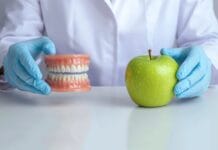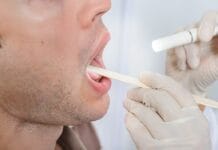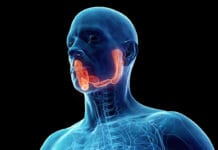One of the first things dental hygiene faculty teach students is proper chair positions and how crucial ergonomics are for career longevity. Is it dental hygiene school without being told by instructors to sit up straight, lower the patient chair so you do not have “chicken wings,” and ensure your feet are on the floor?
As a dental hygiene educator, I know I am trying to instill in my students the importance of this because their bodies will thank them later.
Fortunately, there are many ways to help improve a dental hygienist’s adherence to ergonomics, such as standing from time to time, ergonomic loupes, and operator stools or chairs, just to name a few. These are great options for clinicians, but they were not always available.
When you were in school or just starting out, did you even use loupes? Did you turn your neck like a giraffe just to get that last piece of lingual calculus on that maxillary molar? Did you raise your arms and shoulders into “chicken wings” because your patient could not lie back to a fully supine position?
Of course, we have all done these things at one point in our careers. However, what happens to our bodies over time when just those few minutes on each patient each day, each month, and each year take a toll?
I had the opportunity to interview Amanda Betances, RDH, BA, MBA, about her personal experience with musculoskeletal injury as a dental hygienist of nine years.
After graduating from high school, she admits she did not know what career to pursue. But Amanda knew that whatever she chose, she wanted to be passionate about it. Her mom, who she considers her best friend, suggested something in the medical field, such as dental hygiene.
Amanda was open to the idea of working with the public and becoming a successful health care professional. She took a chance and applied to her local hygiene program, Bristol Community College, and was accepted.
Since graduating from dental hygiene school, Amanda has worked in both the private and public sectors of the dental hygiene field. She mentioned that “working in both settings has allowed me to gain more skills and experience alongside a diverse population. Working in the public sector gave me more insight into the community’s need for oral health care.”
Amanda’s favorite part of dental hygiene is the educational aspect. She enjoys “educating patients on the importance of preventing, treating, and maintaining optimal oral health. Not only does it increase the community’s knowledge of the importance of dental hygiene, but it’s also a rewarding career that allows me to be involved, help, and give back to my community.”
We went straight to the “why” behind Amanda’s musculoskeletal injury to start the interview.
Machado: Tell us about your experience with ergonomic struggles and your injury.
Betances: I completely neglected the importance of good ergonomics in dental hygiene from the beginning of my career until last year when I recognized an issue with my neck and shoulders. It was me being completely ignorant of the fact that my professors, colleagues, and research had warned me about the negative effects of poor ergonomics.
I was in my early twenties when I began my career in dental hygiene. At that very time in my life, you couldn’t tell me anything. I knew it all. I knew for a fact that it was impossible for dental hygiene to cause musculoskeletal disorders. My comments were along the lines of “How could anyone sustain injuries from practicing dental hygiene? You are sitting in a chair most of the time.” Ignorant of all the other aspects that go into the career, such as constant repetition, awkward positions, poor lighting, sitting for long periods of time, forceful movements, and stress.
At this point, after practicing for so long with no resources to improve my posture and no true understanding of the importance of good ergonomics, it was too late, and permanent damage had been created.
Machado: When did you notice the injury, and what were the symptoms?
Betances: About three years ago, I started to notice issues and pain associated with my neck and shoulder areas. The onset of pain started when I was simply reaching into my cabinet for a coffee mug. I couldn’t quite reach it, so I overextended my right arm and shoulder, causing instant pain and muscle spasms.
Of course, with a high pain tolerance, I just thought I pulled a muscle and it would recover naturally in a week or so. I was wrong. That “small” inflicted injury turned into two years of chronic neck and shoulder pain.
After ignoring the injury for 12 months, I went to my physician. He had noted chronic neck spasms, the straightening of my cervical spine, and chronic inflammation. He diagnosed me with a sprained neck. After hearing about what I do for a living, he suggested six weeks off work with rest and six weeks of intensive physical therapy, along with anti-inflammatory medications.
I was about 80% better upon my return to work, practicing as a dental hygienist. After two months of practicing dental hygiene again, I was right back to square one: chronic pain in my neck and shoulders. At this point, I knew my poor ergonomics, repetitive job motions, and posture were contributing to my chronic pain and were the reason I was not 100% better.
A year after visiting my physician, I was back, this time receiving a prescription for an MRI and a referral to a spine specialist. Then, a dental hygienist’s worst nightmare, the doctor came back with the MRI report and revealed I was suffering from two bulging discs in the cervical spine C1-C4, and a chronic case of myofascitis (a chronic condition that causes pain in the muscles and fascia caused by chronic muscle strain and aseptic inflammation).
At this point, I knew my dental hygiene career eventually had to come to an end because permanent damage was done.
Machado: Besides the physical pain, how has the diagnosis changed your life?
Betances: Besides not being able to comfortably perform my job as a dental hygienist, the quality of my life has changed. Mentally, my health has especially declined because I went from being super self-sufficient to needing help with basic life tasks. When my muscles flare up and go into a spasm, I am unable to work out, drive, sit down to watch TV, sweep, mop, fold laundry, and lift things above my head.
The long-term effects of the injury have forced me to alter my daily tasks, such as changing my workouts from lifting weights to doing mostly cardio and using a computer chair (with a back) instead of my couch to watch TV.
On the positive side, it has forced me to prepare for my career transition, which is something that I eventually needed to do. Lastly, my diagnosis has altered my way of thinking and made me want to slow down and enjoy each moment of my life instead of living in a rush.
Machado: How has your boss reacted to your injury and diagnosis?
Betances: My boss was very understanding when I asked for accommodations in the office. I explained I would no longer be able to constantly lift the instruments out of the autoclave or carry delivered boxes of supplies up the stairs. It’s also helpful that my boss works around my schedule because I have had many doctor appointments to deal with my injury. He also provides health care benefits, allowing me to obtain the necessary treatment.
Unfortunately, the office did not offer me any extra ergonomic equipment to improve my dental hygiene experience. Instead, my boss offered suggestions such as standing up for hygiene appointments. Overall, there’s only so much the office can do for me. Most of it falls on me.
Machado: What have you been doing since your diagnosis in terms of working? Inside and outside of work?
Betances: Currently, I am still working as a dental hygienist and clinical dental hygiene educator. I have cut back on my clinical hygiene hours due to the severity of my injury. I went from being able to work 38-plus hours a week as a clinical dental hygienist to working 26 hours a week.
I still teach as a clinical professor during the fall/spring school year. Outside of work, I am mainly focused on recovery and researching more ways to help myself with my neck/shoulder injury. I continue to make sure I stay physically active.
Machado: Do you have any stretches or exercises you use regularly and would like to share with others?
Betances: I do many daily stretches recommended by my physical therapist to help my neck and shoulder pain improve. All these stretches were also performed at each physical therapy session twice a week for six weeks. After attending six weeks of physical therapy, it was recommended that I continue these stretches daily. Some of these simple stretches include gentle neck rolls, chin tucks, isometric neck holds, and arm circles.
Yoga has also helped improve my pain and mobility. Some yoga poses include cobra, downward-facing dog, and child’s pose.
Machado: What resources have you used to help improve your ergonomics?
Betances: I use dental loupes to help improve my ergonomics. Before getting loupes, ensure that you are properly measured and fitted by a professional consultant for optimal success with the equipment.
Also, alternating sitting and standing between patients makes a huge difference and forces me to use my core and legs to bend forward instead of my neck.
I have regular visits to the chiropractor, massage therapist, and acupuncturist. I also use muscle-relief gels and electrical stimulation to help keep the blood flowing in my muscles and align my spine.
Machado: What equipment or products do you wish you had to help with ergonomics?
Betances: I wish I had purchased ergonomic loupes instead of the traditional style. The difference is that ergonomic loupes allow you to have a neutral neck and head position while treating patients. In fact, if you attempt to move your head/neck up or down, you will lose direct vision and will not be able to see the patient’s oral cavity.
Another thing I wish I had invested in was a saddle chair. The traditional saddle chairs come without a back and are ergonomically designed to help the dental professional sit in a neutral, upright position, maintaining proper posture.
Lastly, I wish I had depended less on my hand scalers and frequently rotated between powered instruments to reduce repetitive hand motions, which would have helped place less pressure on my shoulder and neck.
Machado: Do you have any observations regarding ergonomics in dental hygiene that you wish more people would take note of?
Betances: I believe offices should invest in ergonomically designed equipment for their employees. Other considerations include ergonomic friendly operatories that focus on preventing dental hygienists from making strenuous movements to access overhead lights, tray tables, and suctions. Instruments should always be maintained or replaced accordingly to ensure efficient and seamless instrumentation. Using a combination of sitting and standing can also help create optimal ergonomics. Magnification loupes should be used to improve posture and prevent constant slouching.
Overall, investing in your employees’ health is beneficial to the practice, creating longevity and a positive working environment.
Machado: Do you have recommendations you would give to dental offices or schools around this topic?
Betances: I would recommend that dental offices and schools continue encouraging ergonomics and good posture. I would also recommend that schools add an ergonomics course to their curriculum, emphasizing the importance of the subject.
Teaching ergonomics is important and should be reinforced throughout the entire duration of the program. Providing students with research and case studies regarding the adverse effects of poor ergonomics can help improve their understanding of the subject.
Offices and schools should provide their employees with the best ergonomically designed equipment to help prevent injuries.
Machado: If you decide to move on from clinical dental hygiene, do you plan to stay in dentistry or health care? If so, what are your thoughts?
Betances: Moving on from clinical dental hygiene has always been in my future. Unfortunately, my injuries will force me to leave sooner than I planned. I would like to stay in health care and utilize my master’s in business administration, but I am also open to other avenues.
Some avenues include education, management, and administration. I am very open, but I would like to stay in health care due to my experience, passion, and knowledge in the field.
Machado: What is the best advice or recommendations you would give to students, new grads, or any dental professional regarding ergonomics?
Betances: Ergonomics in dental hygiene is vital to sustaining a long-term dental hygiene career. Poor ergonomics can lead to an increased risk for musculoskeletal disorders, forcing dental hygienists to terminate their clinical careers. The best advice I could offer students, new grads, or any dental professional is to take the time to master the proper patient/clinician relationship before practicing dental hygiene.
After mastering good ergonomics and proper form, continue to maintain good ergonomics by taking care of your body and using other modalities such as stretching and practicing yoga.
In Closing
Amanda ended the interview by saying, “I think I have covered everything, but if anyone has any questions or comments concerning ergonomics or just wants to ask me more about my personal journey, they can email me at prophylove@gmail.com.
I hope this interview can help educate other hygienists and dental professionals in the field. I also hope it can prevent injuries and allow our hygienists worldwide to have a healthy, long-lasting dental hygiene career.”
Before you leave, check out the Today’s RDH self-study CE courses. All courses are peer-reviewed and non-sponsored to focus solely on high-quality education. Click here now.












